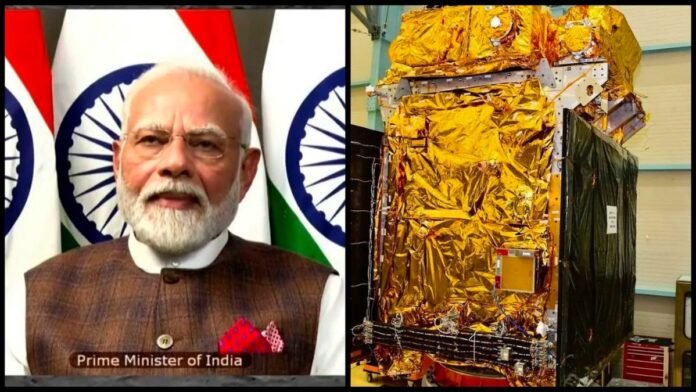On Wednesday, August 23, Chandrayaan-3 safely touched down on the lunar surface and Prime Minister Narendra Modi presented a new significant ISRO project while speaking to the nation.
PM Modi said, “In order to perform a comprehensive analysis of the sun, the ISRO will now complete the ADITYAL-1 mission. , Venus is one of the ISRO’s objectives.”
The next ISRO Aditya L-1 mission is renowned for its astonishing innovation and is set to launch around the end of August or the beginning of September. This project adds a lot of distinctive elements and is regarded as the most complicated mission undertaken by the Indian space agency to date.
It is noteworthy that India is beginning its initial steps toward creating a “space observatory.” The spacecraft will continuously observe and study the Sun.
Although India has not yet sent a spacecraft there, a Lagrange point is a place between two large celestial bodies like the Sun and Earth. At this point, the gravitational pulls produced by both objects are equal, keeping the spacecraft’s position. Getting the spacecraft to the proper place, 1.5 million kilometers from Earth, tucked between our planet and the Sun, requires tremendous navigational skill. Furthermore, maintaining the stability of the spacecraft has become much more challenging.
Aditya will be based in Lagrange-1, one of the five Lagrange points in the Sun-Earth system.
The two primary instruments on Aditya L-1, SUIT and VELC, were entirely built in India by researchers there. Notably, VELC will do “spectropolarimetric measurements” to examine the Sun’s magnetic field from orbit, a first for any country. As a result, the information generated by this technology will significantly increase scientific knowledge.
According to the ISRO website, Aditya L1 will be the first Indian mission to study the Sun from space. The Lagrange point 1, or L1, which is around 1.5 million kilometers from Earth, will be the location of the spacecraft in a halo orbit. The ability to continuously observe the Sun without any occultation or eclipses is the major advantage of having a satellite in the halo orbit around the L1 point. Seeing solar activity and how it affects space weather in real time will be easier. Seven sensors aboard the spacecraft use electromagnetic, particle, and magnetic field detectors to study the photosphere, chromosphere, and corona. Four payloads use the unique vantage point L1 to observe the Sun directly, while the remaining three payloads conduct in-situ particle and field investigations at the Lagrange point L1. This makes it possible to conduct extensive scientific investigation on how solar dynamics spread across the interplanetary medium.
On the website, it states that “The Aditya L1 payloads’ suits are expected to provide the most important information to understand the problem of coronal heating, coronal mass ejection, pre-flare and flare activities and their characteristics, dynamics of space weather, propagation of particle and fields, etc.”
Among the key objectives of Aditya L-1 are the following:
Exploring the dynamics of the solar high atmosphere, the chromosphere, and the corona.
Examining the processes that cause the chromosphere and corona to heat up as well as understanding the mechanics of partly ionized plasma and the beginnings of solar flares.
Collecting information on plasma and in-situ particles to facilitate the study of solar particle dynamics.
Examining the physics underpinning the heating of the solar corona.
Measuring the density, velocity, and temperature of coronal and coronal loop plasma with diagnostics.
Coronal mass ejections (CMEs) behavior, origin, and evolution are being studied.
Identifying the sequential processes taking place at distinct levels (such as the chromosphere, base, and extended corona) that result in solar eruptive episodes.
Analyzing the solar coronal magnetic field structure and taking magnetic field measurements.
Identifying the causes of space weather, such as the solar wind’s composition, behavior, and place of origin.
Conclusion:-
The ISRO Aditya L-1 mission, set to launch in August or September, is India’s first space observatory project. The mission aims to continuously observe and study the Sun, keeping a watchful eye on the celestial body 24/7. The spacecraft will be based in Lagrange-1, one of the five Lagrange points in the Sun-Earth system. The two primary instruments on Aditya L-1, SUIT and VELC, were built in India by researchers. The mission will be the first Indian mission to study the Sun from space, with the Lagrange point 1, or L1, being the location of the spacecraft in a halo orbit. The mission will explore the photosphere, chromosphere, and the Sun’s outermost layers using electromagnetic, particle, and magnetic field detectors. Key objectives of Aditya L-1 include examining the dynamics of the solar high atmosphere, chromosphere, and corona, examining processes causing chromosphere and corona heat, collecting information on plasma and in-situ particles, studying the physics underpinning solar corona heating, measuring the density, velocity, and temperature of coronal and coronal loop plasma, studying coronal mass ejections, identifying sequential processes causing solar eruptive episodes, analyzing solar coronal magnetic field structure, and identifying causes of space weather.



